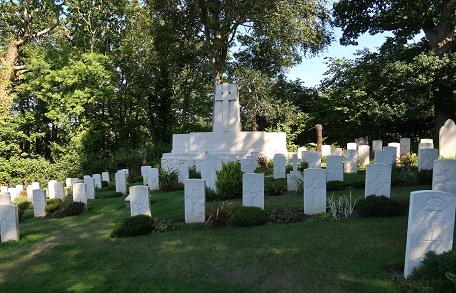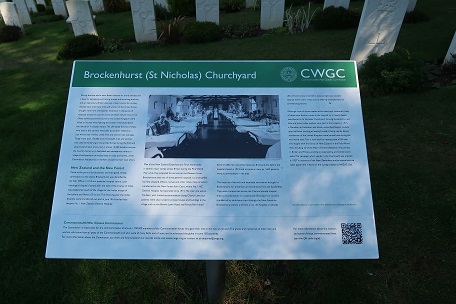EDMUND MONTAGU PRINSEP FISHER
2nd Lieutenant, 194301, 36th Divisional
Ammunition Column, Royal Field Artillery
Died in London on 31 March 1918, having been
invalided home from St. Quentin, France. He was 46.
Buried in Brockenhurst churchyard, Hampshire

Brockenhurst churchyard and memorial
(Click to enlarge)
Photograph by Carol O'Driscoll
Edmund Montague Prinsep Fisher was born on 13 January 1872 to Herbert W. and Mary Louisa Fisher, née Jackson, at Brompton, Middlesex.
He was one of a family of eleven children, the 1881 census shows the family at Hove, East Sussex with father Herbert William, aged 56, mother Mary Louisa, 39, Florence Henrietta, 17, Emmeline Mary Morris, 12, Adeline Maria, 10, Edmund, 9, Hervey George Stanope, 7, William Wordsworth, 6, Charles Dennis, 3 and Cordelia, aged 1. Herbert had been tutor and secretary to the Prince of Wales, later King Edward VII.
The 1891 census shows the family at 19, Second Avenue, Hove. Herbert, 66, is registered as a barrister-at-law, solicitor and JP. Mary is now 49. With them on census evening are Adeline, 20, Edmund, now a 'student of architecture' aged 18, Hervey, 17, Charles, 13, Cordelia, 11, and Edwin, aged 7.
The Fisher family were related by blood or marriage to other well-known or influential families. Mary Jackson's sister, Julia Prinsep Jackson had married firstly Herbert Duckworth, their son Gerald started the publishing company. Her second marriage was to Leslie Stephen, who organised and wrote much of the Dictionary of National Biography. Leslie Stephen's first wife had been Harriet, daughter of the author William Makepeace Thackeray. Leslie's children Vanessa (Bell) and Adeline Virginia (Virginia Woolf), Edmund's cousins, gave links to the Bloomsbury Group. The Princep family were also related to the Fishers.
Edmund's siblings, through marriage, extended his connections. Florence's second marriage in 1913, to Francis Darwin, Charles Darwin's son, gave him introductions to the Darwin and Wedgwood families. Adeline married Ralph Vaughan Williams, the composer. Edmund's brother Herbert Albert Lauren (known as Hal), president of the Board of Education, was the prime mover of the Fisher Education Act, 1916, which raised the school leaving age to fourteen among other reforms. William entered the Navy, later becoming an admiral. In May 1917 he was appointed director of the newly formed anti-submarine division.
The Thackerays were cousins to the Ritchie family, their cousins were the Freshfields of Kidbrooke Park, Forest Row. Probably through this extended cousinship Edmund met Janie Magdalene Freshfield, daughter of Douglas Freshfield and his wife Augusta, née Ritchie. Edmund and Janie were married on 6 June 1899 at Holy Trinity, Forest Row. They had seven children, John Hervey, Herbert Douglas, Roderick, Magdalene, Katherine, Thoby and Mark. The Freshfields were also related to the Kekewiches, the Darwins were related to the Hambros. Members of the Kekewich and Hambro families also owned Kidbrooke Park at some time.
By 1901 Edmund is a fully qualified architect living at 5, Swan Walk, Chelsea, living there until he volunteered for war service. His designs are described as 'domestic' but this was domesticity on a large scale. He was employed by wealthy or gentry families, designing houses that 'appear to grow out of the ground as natural parts of the surrounding scenery' (obituary, The Times Digital Archive). He also designed many schools and some university and office buildings. In Forest Row Edmund designed Wych Cross Place, completed in 1903, for his father-in-law and also the Jubilee Fountain placed in the centre of the village.
Edmund's brothers, William and Charles served in the Navy in WWI. Both fought in the Battle of Jutland, William as captain of a battleship. Charles, a member of the Royal Navy Volunteer Reserve aged 38, died during the battle. Arthur had died in March 1902 from injuries sustained during the Second Boer War.
Edmund was considered too old for active service at the beginning of the war, instead he volunteered in 1915, working as a hospital orderly helping with X-ray work at the Hôpital Temporaire d'Arc-en-Barrois at Haute-Marne, France. This was an emergency evacuation hospital for French troops organised and staffed by British and other allied volunteers.
Casualties during the war were such that a man like Edmund who was too old (at 42) to fight in 1914 was accepted for active service later on. Edmund completed training for the Royal Field Artillery by June 1917. The RFA provided artillery support for the infantry, Edmund served during the Ypres Salient engagement and the Battle of Cambrai.
In January 1918 he developed appendicitis and was invalided home. He was treated at Lady Inchcape's Military Hospital which was affiliated to the Queen Alexandra's Military Hospital. Lady Inchcape had opened her home in Seamore Place, Mayfair, London as a hospital in 1915. Registered as 'Military, Convalescent' this small hospital took ten officers at a time. Many such small voluntary hospitals existed throughout the war.

Information board in Brockenhurst churchyard
(Click to enlarge)
Photograph by Carol O'Driscoll
At that time an operation to remove the appendix was very dangerous, often it was hoped that rest and careful nursing would effect a remission or cure. In Edmund's case such care did not help. He developed peritonitis and died on 31 March, Easter Day, 1918. He was buried in the churchyard of St. Nicholas, Brockenhurst, Hampshire where he and other members of the family were buried. His gravestone reads:
'In memory of Edmund Montagu Prinsep FISHER, Second Lieutenant RFA, son of Herbert William FISHER, born Jan 13th 1872, died March 31st 1918'.
Edmund was entitled to the Victory Medal and the British War Medal. The memorial book in Holy Trinity Church is signed by his widow, Janie Magdalene Fisher, Wych Cross Place.
Vivien Hill
7 November 2018

